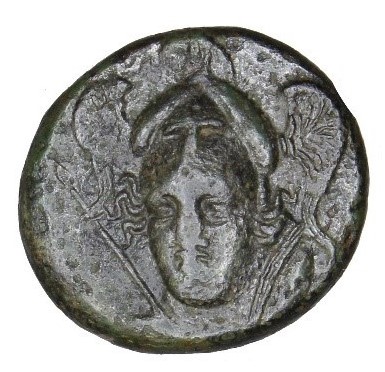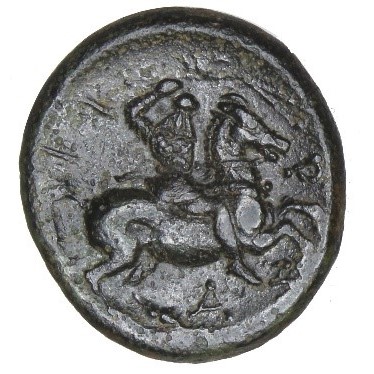Acquisition number: 2018.06
Obv.: facing head of Athena Parthenos with helmet pushed back on head, with spear and shield over her shoulder.
Rev.: armoured Thessalian warrior on horseback, brandishing flail; ΦΑΡΣΑ (abbrev. for ΦΑΡΣΑΛΙΩΝ, ‘of the Pharsalians’), letters of the city name, run around the circumference of the field.
Title: Trichalkon of Pharsalos - 2018.06
Acquisition number: 2018.06
Author or editor: Peter Londey
Culture or period: Hellenistic.
Date: 4th - 3rd century BC.
Material: Metal - Bronze
Object type: Coins - Greek
Dimensions: 21mm (w)
Origin region or location: Greece
Origin city: Pharsalos.
Display case or on loan: 5
Keywords: Coin, Greek, trichalkon, Pharsalos, Athena, Parthenos, Thessaly, Philip II of Makedonia, Chaironeia
Classical Numismatic Group, TheBCD Collection of the Coinage of Thessaly (Auction XV [3 January 2012], Lancaster PA and London, Triton, 2012), II, 672.1 (same dies).
O. Hoover, Handbook of Greek Coinage 13 vols (Classical Numismatic Group, Lancaster, PA, 2009-2013), 4, 648.
2018.06
Trichalkon of Pharsalos
Bronze 10.19 g. 21 mm. 4th-3rd centuries BC.
Obv.: facing head of Athena Parthenos with helmet pushed back on head, with spear and shield over her shoulder.
Rev.: armoured Thessalian warrior on horseback, brandishing flail; ΦΑΡΣΑ (abbrev. for ΦΑΡΣΑΛΙΩΝ, ‘of the Pharsalians’), letters of the city name, run around the circumference of the field.
Situated at the southern end of the great plain of western Thessaly, Pharsalos (with Larissa and Pherai) was one of the three major Thessalian cities. Pharsalos became particularly influential in the reign of Philip II of Macedon. Philip’s early ties were mainly with Larissa, and it was with Philip’s help that the Thessalians finally ended the mid-fourth century dominance of Pherai. But in the 340s, after Philip became archon of Thessaly, he seems to have favoured Pharsalos.
After the Battle of Chaironeia (338 BC), two of Philip’s four Thessalian tetrarchs, Daochos and Thrasydaios, both of Pharsalos, also became the Thessalian representatives on the Delphic Amphiktyony. The remains of an impressive dedication by Daochos, with statues of eight members of his family and the god Apollo, may still be seen at Delphi.
The obverse of the coin depicts a horse, a common image on Thessalian coinage. Thessaly was an area of open plains, suited to agriculture and the raising of horses, and as a result was renowned for its cavalry.
Purchased by the Friends of the ANU Classics Museum in memory of Jill Greenwell.
Classical Numismatic Group, TheBCD Collection of the Coinage of Thessaly (Auction XV [3 January 2012], Lancaster PA and London, Triton, 2012), II, 672.1 (same dies).
O. Hoover, Handbook of Greek Coinage 13 vols (Classical Numismatic Group, Lancaster, PA, 2009-2013), 4, 648.

